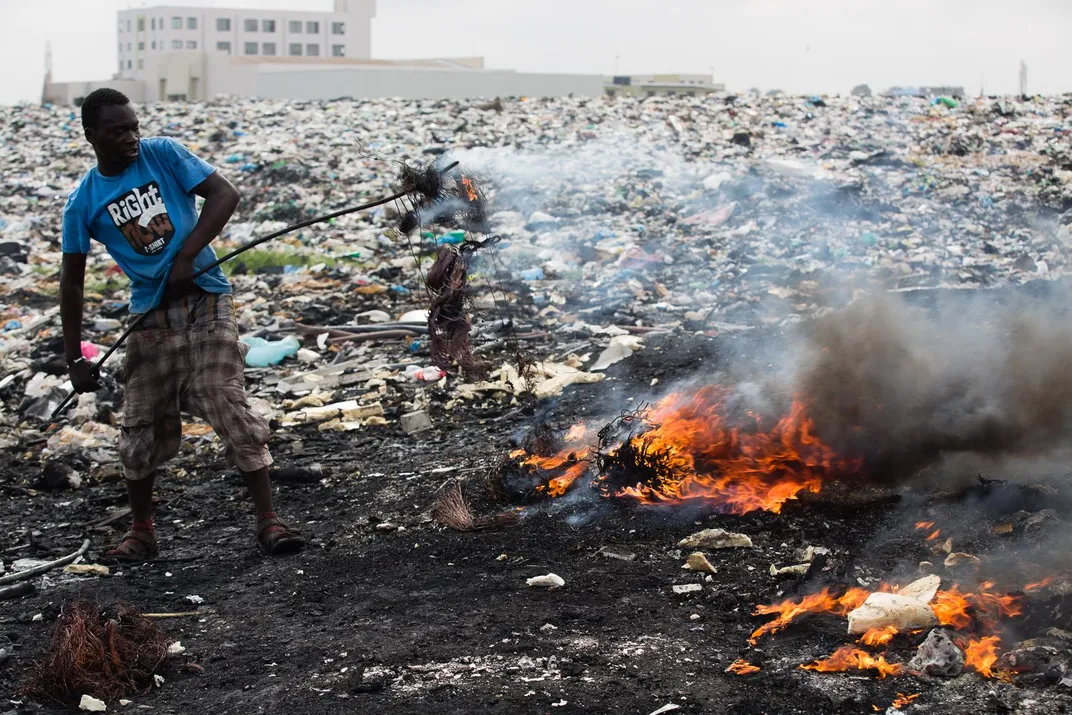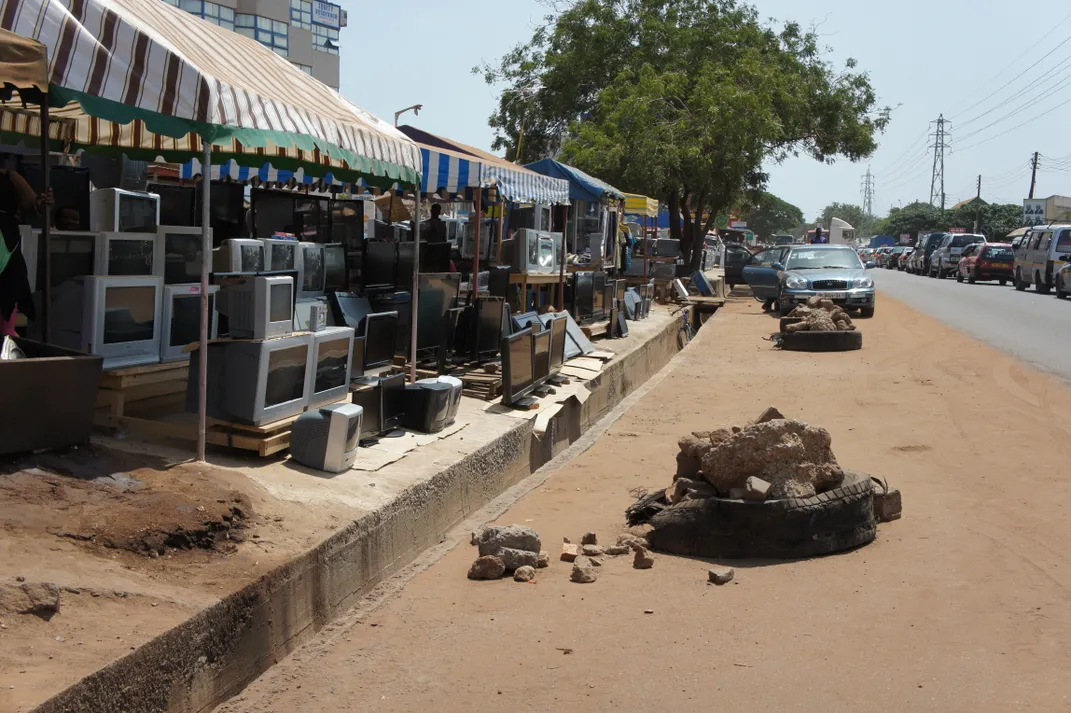The Burning Truth Behind an E-Waste Dump in Africa
Ending the toxic smoke rising from an iconic dump in Ghana will take more than curbing Western waste
/https://tf-cmsv2-smithsonianmag-media.s3.amazonaws.com/filer/bb/26/bb2665df-3384-4a0f-a5a4-ef9fa7b0d8e0/dsc06022.jpg)
They are some of the most iconic photos in environmental journalism: young African men, often shirtless, standing over small fires fueled by digital detritus imported from richer countries. The toxic smoke swirls around them and over Agbogbloshie, the roughly 20-acre scrap yard in the heart of Accra, Ghana, where these men live and work.
During the last decade, some of the world’s most respected media organizations have transformed Agbogbloshie into a symbol of what’s believed to be a growing crisis: the export—or dumping—of electronic waste from rich, developed countries into Africa. It’s a concise narrative that resonates strongly in a technology-obsessed world. There’s just one problem: The story is not that simple.
According to the United Nations Environment Programme, 85 percent of the e-waste dumped in Ghana and other parts of West Africa is produced in Ghana and West Africa. In other words, ending the export of used electronics from the wealthy developed world won’t end the burning in Agbogbloshie. The solution must come from West Africa itself and the people who depend upon e-waste to make a living.

Agbogbloshie is not a pleasant place to work. Most of the site is threaded by muddy lanes that cross in front of dozens of small sheds holding recycling businesses. Inside, owners, their families and employees manually dismantle everything from automobiles to microwave ovens. E-waste, defined as old consumer electronics, is actually a very small part of the overall waste stream in these lanes, filled with the clanking of hammers on metal. And phones, laptops and old TVs aren’t the only things that can be dangerous when recycled improperly.
At Agbogbloshie, burning takes place at the edge of the site, and most of what’s burned is automobile tires, which are lined up for hundreds of feet and left to smolder, producing dangerous levels of carbon monoxide and other hazardous substances. Later, workers will gather up the steel left behind.
Elsewhere, around 40 men, most in their teens and early 20s, tend five- and ten-pound bundles of burning insulated copper wire. They contain everything from harness wires used in automobiles to USB cables. In Ghana and across the world, insulated wire is highly sought by recyclers big and small, who covet the metal but not the insulation. The task of the recycler is to separate the two substances as quickly and economically as possible.
In the course of a day, perhaps a few hundred pounds of wire are burned, with the remains sold for recycling to local metal dealers and Nigerian traders who frequent the area. Depending on when the insulation was made, the smoke emitted can contain dioxin, heavy metals and other pollutants that pose a strong threat to human health.
Over the last half century, technologies have been developed to do that separation in an environmentally sound manner. But even the lowest-cost solutions tend to be too expensive for Ghana’s capital-poor recyclers. And if they were affordable, green methods would still be too slow compared to setting the wire on fire and burning off the insulation.
The site poses an undeniable risk to air quality and human health. But solving the problem is about more than stopping Western exports of old electronics.
“The problem is that reporters come here thinking this is the destination for old laptops exported from the United States,” explains Robin Ingenthron, CEO of Good Point Recycling in Burlington, Vermont. His firm exports used, working laptops to Ghana. “But this isn’t the destination at all. The computer shops are.”

To understand what he means it’s necessary to leave Agbogbloshie and take a ten-minute taxi ride to Bugi Computers, a small, independently owned electronics repair and refurbishment business in a residential neighborhood. Inside, Steve Edison, a self-taught computer repairman, is busy fixing a laptop that a customer brought in. The shop is compact, perhaps the size of a small bedroom, and it’s packed with used laptops, accessories and monitors purchased from Ghanaian importers who, in turn, purchase them from people like Ingenthron.
“If something breaks, I keep the parts to use for repair or a new computer,” Edison says as he leans over the laptop, carefully soldering a circuit board. It certainly looks that way. Cables hang from hooks in the walls, spare hard drives are stacked on his work desk and memory chips are kept in display cases. He sells around ten newly refurbished computers per day, assembled from machines and parts that people in wealthier countries didn’t want.
Edison’s business isn’t unique. There are thousands of similar repair and refurbishment businesses across Ghana and West Africa, catering to consumers who can’t afford, or don’t want, new machines. It’s an important business that plays a key role in bridging the so-called digital divide between wealthy consumers in developed countries and those in places like Ghana.
The most detailed study of the used electronics issue was performed in 2009 by the UN Environment Programme, which found that Ghana imported 215,000 metric tons of “electric and electronic equipment” that year. Thirty percent of that total was new equipment. Of the 70 percent that constituted used goods, 20 percent needed repairs and 15 percent—or roughly 22,575 tons—was unsellable and bound for the dump.
That’s a lot of unusable electronics (many of which are damaged in transit to Ghana). But it’s less than one percent of the 2.37 million tons of e-waste generated by the United States in 2009, and a nearly imperceptible fraction of the 41.8 million metric tons of e-waste generated globally in 2015. In other words, Agbogbloshie is not a global dumping ground. Like most places on Earth, it’s struggling to deal with what it generates on its own.
Edison gives a concise accounting of how it works: “If something can’t be fixed anymore, I then sell it to the carts,” he says. The carts are four-wheeled, heavy-duty wheelbarrows operated by men who spend their days walking Accra, looking for used goods—electronics to furniture—that can be bought and sold for recycling. If the objects contain metal, they’re bound for Agbogbloshie, where they’re sold to (or pre-ordered from) the dozens of small businesspeople who own stalls at the site.
Not everything is recycled at Agbogbloshie. Much of it is recovered and re-used instead. “People in the West forget that if they send something to Ghana, it’s used a lot longer than it is back home,” Ingenthron points out. “Where I come from, that’s considered good for the environment.”

It’s by no means a simple picture, and it eludes simple solutions. “At first you think these guys are doing something really bad and they should become plumbers,” says D.K. Osseo-Asare, a Ghanaian-American architect who is co-lead on the Accra-based Agbogbloshie Makerspace Project, or QAMP, an effort to change perceptions and the economy of the site. “But then we said, let’s arm them with information so that they can do things better.”
QAMP set up a shed among the established recycling businesses and spent months getting to know the site, the people who work there and what they need. Most of the workers are migrants, oftentimes with little education and few connections in the big city, Osseo-Asare tells me. “They’re here to make money, quickly. If we want people to do this work in a safe and environmentally sound way, [making a living] has to be part of [it].”
With that in mind, QAMP is developing a digital platform that can be loaded onto the smartphones used by scrap workers, which will begin beta-testing in January. In addition to offering a Twitter-like scrap marketplace that will allow scrappers to find and buy metal throughout Ghana, the digital platform includes health and safety information.
“If we beat people over the head with safe e-waste recycling, it will never work," says Osseo-Asare. "But if you help them find business, and you give them some interesting pieces of info regarding safety, they might look at it.” Meanwhile, QAMP is working with the Agbogbloshie community to develop new products out of the junk sold at the site, rather than sending it for direct recycling.
Plastics, which generally have a low value in the recycling chain, are a natural target. Recognizing this, QAMP has worked on simple equipment that can help transform the plastics generated at Agbogbloshie into recycling bins. “The idea, again, is to help them make money,” Osseo-Asare explains.
Meanwhile, Robin Ingenthron is working with his Ghanaian importers to establish a model in which every ton of electronics that he exports must be offset by a ton of electronics that’s collected and recycled properly in Ghana. If Ghanaian importers want access to his used electronics in Vermont, they’ll have to comply. Ingenthron believes it will work, in large part because he ran a similar “fair trade” recycling business with Malaysian importers for nine years.
Agbogbloshie won’t be solved quickly. It plays a key economic and environmental role in Accra, and shutting it down would just shift what happens there to another location. “You have to change how people perceive the place,” Osseo-Asare explains. “Once they see the potential, they understand that the solution comes from Agbogbloshie and not from outside.” Patience, as well as hope, should take care of the rest.
/https://tf-cmsv2-smithsonianmag-media.s3.amazonaws.com/accounts/headshot/minter.JPG)
/https://tf-cmsv2-smithsonianmag-media.s3.amazonaws.com/accounts/headshot/minter.JPG)